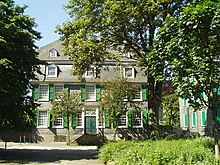Friedrich-Engels-Allee
The Friedrich-Engels-Allee is an inner city main road in Wuppertal and part of the national highway 7 (B 7). The Friedrich-Engels-Allee residential area in the Barmen district is also named after the street . It was named in 1946 after Friedrich Engels , who, alongside Karl Marx, was the developer of what is now called Marxism , the revolutionary social theory of society, who was born on the street in 1820 and grew up in the Engels house on the street.
topography
Coming from Döppersberg , the street begins as a continuation of the Bundesallee in the Elberfeld district , close to the Barmen district boundary at the Haspel-Häuser . It runs as a west-east axis parallel to the Wupper to the east to the traffic junction Alter Markt in the district of Barmen and there it merges into the street Höhne .
The avenue begins as a five-lane, wide street in a loosely built-up area with authorities, commercial and service companies. The former route of the tram is used as a wide median with greenery. In the further course the road narrows to four lanes and the green strip is omitted; the streetcar used to share the road with car traffic. Friedrich-Engels-Allee is now densely built on both sides with old villas and residential houses. Many of these houses are half-timbered buildings from the 19th century, on some of them there is the typical Bergisch slate facing with the characteristic green doors and shutters. It is lined here by old trees on the sidewalk, so that one can still speak of an avenue today.
In the further course the street at the so-called Loher Kreuz widens again, and a green strip marks the old tram route. In the last section it runs directly along the Wupper and becomes seven lanes at the Alter Markt traffic junction.
history
The mayor of Barmer called for donations in 1811 to convert the former unpaved country road into a spacious avenue and paved road with a stone ceiling. Large parts of the street in the Unterbarmen district were expanded as early as Napoleon's time at the beginning of the 19th century. Linden trees were planted along the road . Her name at the time was simply " Allee ".
In 1825 the Haspelhäuser and numerous other villas were built on this road in the middle of the 19th century.
The road soon developed into an important traffic artery for the two then independent cities of Barmen and Elberfeld. The two cities were united in 1929 and were given the name Wuppertal in 1930. Shortly after the NSDAP came to power under Hitler in January 1933, the representative avenue was renamed Adolf-Hitler-Strasse . According to plans by the NSDAP, a wide parade and parade street was to be created here. At the Haspel , the point of contact between the two parts of the city, the avenue should then flow into the Adolf-Hitler-Platz , which had yet to be created , and thus represent the new center of the city.
After the Second World War , the extensive expansion plans of the NSDAP were dropped and the street was renamed Friedrich-Engels-Allee on February 4, 1946 . The B 7 was expanded in the mid-1960s. The tram ran along here until 1987, when the tram was shut down throughout Wuppertal. For the most part, the route was converted into a green strip.
At the beginning of the 2000s there were plans to redesign the street section in the "historical part" between Haspel and Loher Strasse. The trees should be replaced. The plans to remove all avenue trees were denied in 2016.
Buildings on the street
Numerous buildings and facilities are located on this street, around 80 of which are entered in the list of monuments of the city of Wuppertal. A further ten objects were examined for the status of historical buildings, but the Rhenish Office for the Preservation of Monuments (RhAD) rejected the applications.
- sorted alphabetically
- House of Barthels
- Haspel campus of the Bergische Universität Wuppertal , formerly the Royal Prussian Building Trade School
- Prison in Wuppertal (Bendahl) , today there is an electronics store on the site and the former German headquarters of the Walmart group
- Bandfabrik Wilhelm Büsgen , former factory and publishing house. Today the commercial center "Alleehaus" is located there, ribbons and braids are still made.
- House of Robert Dahlmann
- DEVK insurance , office
- Engels House , birthplace of Friedrich Engels Sen.
- House at Friedrich-Engels-Allee 140
- Residential building Friedrich-Engels-Allee 142
- House at Friedrich-Engels-Allee 146
- Haus Gonnermann , known as the former Historical-Cinematographic Museum
- Graue Panther , headquarters of the party (dissolved in early 2009)
- Grünsiegelpassage (closed after the major fire in 2001)
- Haspel houses , the city archive is housed here (as well as the Liegnitz collection ).
- Hotel Hegelich
- Junior University Wuppertal
- Friedrich-Engels-Allee health resort
- District court and district court on the island of justice
- Opera house of the Wuppertal stages
- Pauluskirche
- Wuppertal Police Headquarters
- TÜV Rheinland
- House chimney (laid down)
- Society House Union
- Wicküler City , former Wicküler brewery
- Wittenstein's house
- Villa Wittenstein
See also
Web links
- Architectural monument overview Friedrich-Engels-Allee in the Wuppertal monument list
- Barmen district by Wolfgang Mondorf
Individual evidence
- ↑ a b Wolfgang Stock: Wuppertal street names . Thales Verlag, Essen-Werden 2002, ISBN 3-88908-481-8
- ↑ Wuppertaler Rundschau Tomorrow's history live, from June 2, 2007
- ↑ Citizens' hearing on the redesign of Friedrich-Engels-Allee (website no longer available), October 2002
- ↑ www.wuppertaler-rundschau.de: Lord Mayor denies rumors: Mucke: Historic avenue trees remain. In: wuppertaler-rundschau.de. Wuppertaler Rundschau, accessed on July 11, 2016 .
Coordinates: 51 ° 15 '53.8 " N , 7 ° 10' 57.7" E







